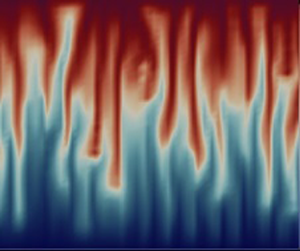No CrossRef data available.
Published online by Cambridge University Press: 26 March 2024

The onset of convection in a horizontal porous medium layer saturated with a nanofluid and heated from below is investigated via linear stability analysis and numerical simulation. The Darcy–Buongiorno model is used to describe the convective transport behaviour of the nanofluid and the settling effect of nanoparticles due to gravity is considered in addition to thermophoresis and Brownian diffusion. The linear stability analysis shows that the gravity settling is a substantial stabilizing mechanism restraining the destabilizing factors such as thermal buoyancy and thermophoresis. The stability threshold is determined by the relative strength of thermophoresis to gravity settling. It is found that the system is destabilized when the thermophoretic mobility prevails. As the nanoparticle size increases, the gravity settling effect is promoted and makes the system more stable. In particular, the onset of instability is dominated by the oscillatory mode once the nanoparticle concentration is in a stably stratified profile across the porous layer. When the Rayleigh–Darcy number  $Ra_D$ exceeds the critical value, the spectrum of the growth rates of the unstable modes rises with increasing
$Ra_D$ exceeds the critical value, the spectrum of the growth rates of the unstable modes rises with increasing  $Ra_D$ and
$Ra_D$ and  $Rn$ (i.e. the concentration Rayleigh number), and eventually the unstable modes in the high-wavenumber region exhibit the same instability. The evolution of the convection is further examined by numerical simulation. The results verify the stability characteristics predicted by linear stability analysis. Moreover, the pattern of fingering convection of the nanofluid concentration is observed once the nanofluid concentration is unstably stratified and the density difference across the porous layer is large enough.
$Rn$ (i.e. the concentration Rayleigh number), and eventually the unstable modes in the high-wavenumber region exhibit the same instability. The evolution of the convection is further examined by numerical simulation. The results verify the stability characteristics predicted by linear stability analysis. Moreover, the pattern of fingering convection of the nanofluid concentration is observed once the nanofluid concentration is unstably stratified and the density difference across the porous layer is large enough.